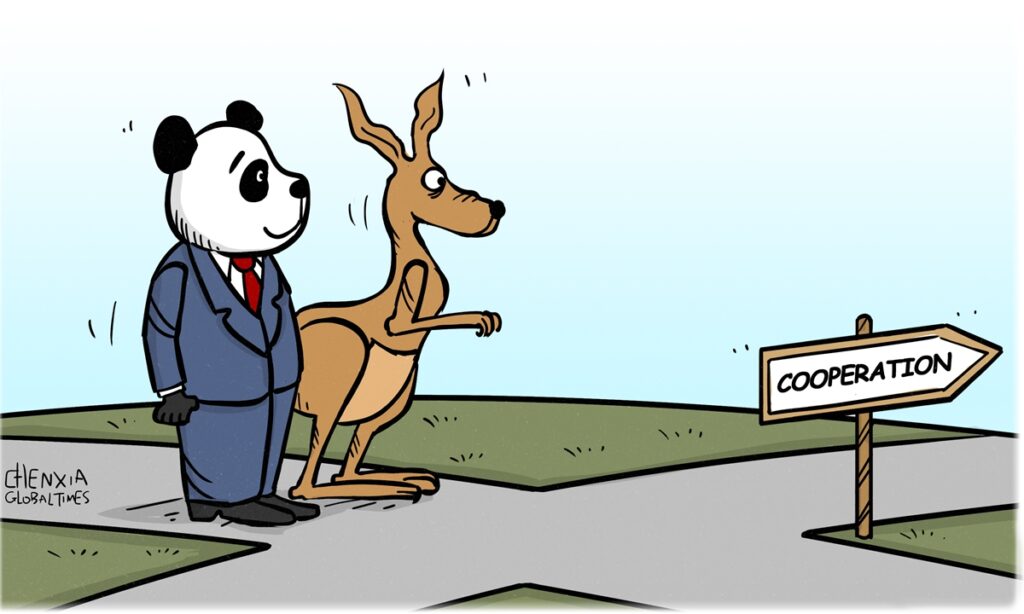To a certain extent, it can be said that Australian Prime Minister (PM) Anthony Albanese’s visit to China is already half successful even before he arrives in Beijing. The mere fact that he is the first Australian PM to visit China in seven years indicates the breakthrough that has been made in China-Australia relations. It is undoubtedly rare for a leader of Australia to not visit China, a country that Australia has huge bilateral trade with, for seven years. Albanese’s visit to China from Saturday to Tuesday puts an end to this phase and turns a new page in China-Australia relations.
The first stop for Albanese and the Australian delegation is reportedly Shanghai, where they will attend the 6th China International Import Expo (CIIE) and visit the booths of Australian companies. Based on the registration figures, this year’s CIIE is a hot event, with Australian companies and organizations such as Rio Tinto, BHP Billiton and the Australian Trade and Investment Commission expected to participate. This is just a fragment of the huge economic and trade relationship between China and Australia. This kind of interaction that promotes mutual respect, mutual benefit and win-win cooperation is not limited to the China-Australia economic and trade level, but is what the relationship between the two countries should always look like.
Over the past seven years, China-Australia relations have gone from getting close to rapidly deteriorating to slowly recovering, following a U-shaped curve. They provide an exemplary case study for China’s relations with the West and even international relations. It is not easy, especially for Western countries, to answer questions like how to deal with China, how to truly achieve mutual respect and mutual benefit and how to maintain diplomatic independence and formulate a China policy that is in one country’s national interest as well as in the common interest of the region and the world amid the deepening strategic competition between China and the US. Countries have made different choices and achieved different results.
Prior to Albanese’s arrival, China and Australia had held friendly consultations on WTO disputes over wine and wind towers since the start of this year and reached a consensus on a proper resolution to them. Canberra has ruled that there are no security risks associated with the Chinese company’s lease of the Port of Darwin, thus giving the green light to the Chinese company’s continued operation of the Port of Darwin. This series of positive messages between China and Australia, which we haven’t seen for a long time, has cleared away most of the obstacles for bilateral relations to come out of their dilemma and get back on the right track, creating a favorable atmosphere for Albanese’s visit to China.
Why are many problems that were so difficult to resolve in the past now overcome? The vivid words of a professor at the University of Sydney point to the answer. He said that Australia has swapped “poking Beijing in the eye and kicking it in the shins because it feels good” with a stated policy of “stabilization.” In issues that are important to China, such as banning Huawei 5G, COVID-19 origins, Xinjiang, and the South China Sea, the previous two Australian governments have engaged in the behavior of “poking Beijing in the eye and kicking it in the shins.” The Albanese government has made adjustments, and this led to a turning point in the China-Australia relationship. To put it simply, it is necessary to respect China’s national interests, especially its core interests, but Australia’s adjustment has gone through a tortuous process.
Of course, we hope that the China-Australia relationship in the future can completely turn the page on this extremely unpleasant chapter. However, considering that the Australian side bore the primary responsibility for the previous deterioration in China-Australia relations, the future will also hinge on Australia’s ability to eradicate internal and external interferences to prevent a recurrence of past mistakes. It’s worth mentioning the role of the US here, as its significant influence on Australia’s policy toward China will persist in the long term.
Albanese visited the US before visiting China, but he also announced his visit to China before his US trip. Some suggest that this indicates that Albanese did not want the uncertainty that might arise during the visit to the US to affect his China trip. Therefore, he “locked in” the China visit schedule in advance. This also indicates that Albanese is consciously balancing the relationships with both China and the US, and has done so rather skillfully. In response to US President Joe Biden’s warning about the risks of dealing with China, Albanese stated that the decision to restart relations with China was “calibrated and deliberate.” We believe that his statement is genuine.
The choice of visiting China on November 4 holds another layer of significance. This day 50 years ago, in 1973, marked the end of a historic visit to China by then Australian prime minister Gough Whitlam, who became the first Australian prime minister to formally visit China since the establishment of diplomatic relations between the two countries. Albanese’s visit to China on the same date, 50 years on, during another critical moment in China-Australia relations, establishes a historical connection spanning half a century and carries symbolic significance for the future of bilateral relations. We anticipate that Albanese’s visit will serve as a new starting point, allowing China-Australia relations to set sail once again and extend the warming trend in the “U” shape of the bilateral relationship further to form an uppercase “J” shape.
(Global Times)




